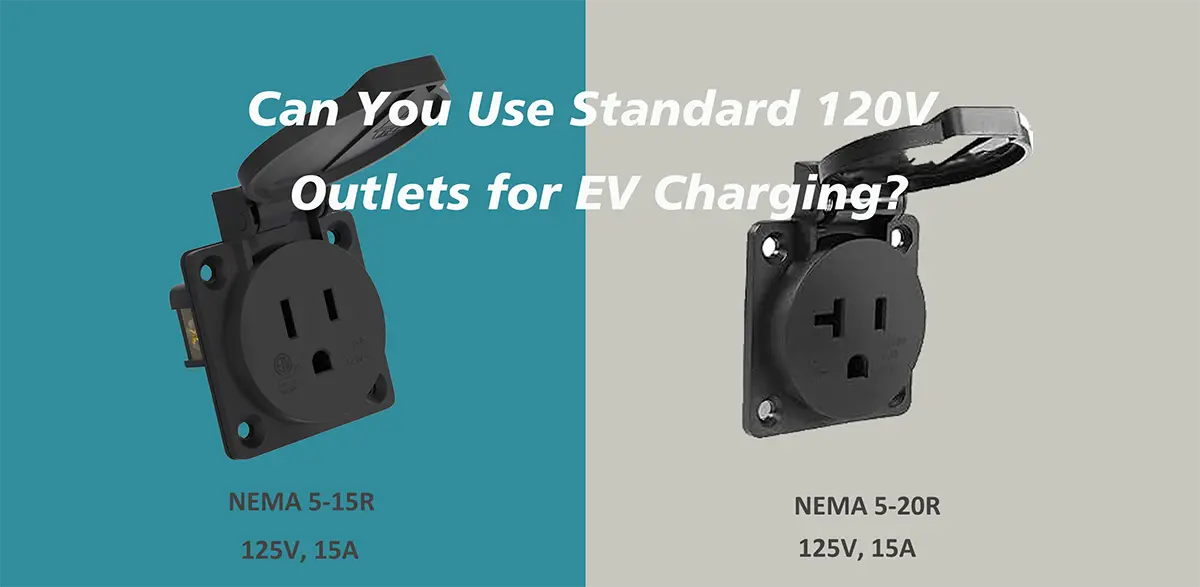
A Clear Comparison of Two Common 120V Outlet Types for Level 1 EV Charging
When you first purchase an electric vehicle, it may come with a portable charging cable designed for a standard wall outlet. These common 120V outlets—known as NEMA 5-15 and NEMA 5-20—are found throughout homes in North America. But what are the differences between NEMA 5-15 vs NEMA 5-20, and are they suitable for regular EV charging?
This article explores the key distinctions between these two outlet types, what kind of charging performance you can expect from each, and whether they can support long-term charging needs.
You may find more detailed introduction about NEMA Connectors for a better understanding about all other Nema outlet and plugs.
1. What Are NEMA 5-15 and 5-20 Outlets?
| NEMA Type | Voltage | Amps | Prongs | Grounded? | Appearance |
|---|---|---|---|---|---|
| 5-15 | 120V | 15A | 3 | Yes | Two vertical + ground (standard outlet) |
| 5-20 | 120V | 20A | 3 | Yes | One vertical + one T-slot + ground |
- Both outlets are 120V single-phase connections
- A 5-20 plug can only fit into a 5-20 receptacle
- A 5-15 plug can fit into either a 5-15 or 5-20 outlet
🧠 Note: Most home wall outlets are NEMA 5-15 rated, even if on a 20A breaker.
2. Charging an EV on 120V: What to Expect
Level 1 charging using a NEMA 5-15 or 5-20 outlet is the slowest method of EV charging. However, it may still be enough for some drivers.
| Outlet Type | Max Current | Power (kW) | Range Gained (per hour) |
| NEMA 5-15 | 12A | 1.4 kW | ~3–4 miles |
| NEMA 5-20 | 16A | 1.9 kW | ~5–6 miles |
🔋 Best-case scenario: You leave your car plugged in overnight and recover ~30–50 miles.
3. When is Level 1 Charging Acceptable?
Level 1 charging with a NEMA 5-15 or 5-20 outlet may be suitable if:
- You drive less than 30 miles per day
- You have no access to 240V power in your garage or driveway
- You’re charging a plug-in hybrid (PHEV) with a small battery
- You’re waiting on a future service panel upgrade or EVSE installation
It’s also useful as an emergency backup or for workplace charging where only 120V outlets are available.
4. Safety and Practical Tips
To safely charge from a 5-15 or 5-20 outlet:
- ✅ Use a dedicated outlet (no other appliances on the circuit)
- ✅ Make sure the outlet is in good condition and grounded
- ✅ Avoid extension cords (unless heavy-duty and EV-rated)
- ✅ Monitor outlet and plug for excessive heat
- ✅ Use a UL-listed portable EVSE from a trusted manufacturer
⚠️ If your breaker trips or the plug feels warm, stop charging and consult an electrician.
5. Why Upgrade to 240V?
While 120V charging can work, most EV owners eventually install a Level 2 charger:
| Feature | Level 1 (5-15 / 5-20) | Level 2 (14-50, 6-50, etc.) |
| Voltage | 120V | 240V |
| Charging Speed | 3–6 miles/hour | 20–35 miles/hour |
| Full Charge Time | 24–48 hours | 4–10 hours |
Level 2 chargers not only charge faster, but also often include Wi-Fi control, load management, and higher efficiency.
📘 Learn more: NEMA 14-50 and Other 240V Outlets for EV Charging
6. Conclusion
You can charge your EV using a standard wall outlet—but it’s not ideal for everyone. For plug-in hybrid drivers, light commuters, or temporary setups, Level 1 charging via a NEMA 5-15 or NEMA 5-20 outlet can suffice.
However, for most full EV owners, a 240V Level 2 setup will dramatically improve convenience and charging reliability.
To understand your best outlet options for faster charging, check out our full guide on 240V outlets.
